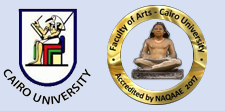عنوان المقال عربي
نظرية العلامات و اثرها في خبرتي الإبداع و التلقي عند أمبريتو إيکو
Document Type
Original Study
Keywords English
Key Words: Literary work, Text, intertextuality, aesthetics of reception, Creative writing, semiotics of openness - signs
كلمات مفتاحية عربي
النص, التناص, العلامات
Abstract English
Umberto Eco (1932-2016) is an Italian philosopher, novelist, and literary critic. He was interested in describing literary texts, and artworks in general, as a connected texture of open signs; whether these signs are verbal or non-verbal. In turn, these signs do not only preserve the meaning, but also they are a form of its presence. Therefore, the aim of Eco was not to prove that the text has one and final meaning. In fact, his research concentrated on proving that the text has multi-meanings and is subject to all different interpretations. On the other hand, reading the open text would be a creative work in which the world created by the author is opened up to the reader. Furthermore, the reader can discover its several meanings. This is named by Eco as the "textual partnership" between the writer and the reader; accordingly, his thesis about the openness of the text, deeply and equally, influenced the concepts of creativity and reception. The study aims at discovering the effects of Eco's theory of signs on the two experiences of creativity and reception, and viewing these experiences as textual experiences, in addition to expressing how the novel is considered to be a style of biography. Moreover, the study discusses what distinguishes the creative writing from the philosophical writing, on one hand, and the scientific writing on the other. Therefore, this study attempts to answer the following questions: Is the text a world of signs that can be interpreted, or is it a meaningless world? In turn, is this meaning the same inherent meaning in the work or is it created by the interaction between the recipient and the artwork? In other words, is it the same intended meaning of the author of the work or is it created by the reader? And if the artwork is a world of signs, then what is the nature of the relation between signs and texts? To answer the previous questions, the study uses the critical analytical method that aims at analyzing the concepts and problems included in the research. The critical reading of the texts does not only express the ideas, but also tries to understand and analyze them, then assess them.
الملخص العربي
اهتم الفيلسوف والروائي الإيطالي أمبرتو إيکو بوصف النصوص الأدبية باعتبارها نسيجًا مترابطًا من العلامات المنفتحة سواء کانت العلامات اللفظية أو غير اللفظية، وهذه العلامات- بدورها- ليست مجرد حفظ للمعاني؛ وإنما حضورًا لها. فقدکان بحثه منصبًا على إثبات أن النص متعدد المعاني خاضع لکافة التأويلات المتباينة. ومن ناحية أخرى، ستغدو قراءة النص المنفتح بمثابة عمل إبداعي يحي فيه القارئ خبرة الانفتاح على هذا العالم الذي ترکه له الکاتب، بل واکتشاف معانيه المتعددة مما يحقق ما يطلق عليه إيکو اسم الشراکة النصية بين الکاتب والقارئ. ومن ثم، قد کان لأطروحته عن انفتاح العمل صداها الواسع على مفهومي الإبداع والتلقي على حدةٍ سواء. تهدف الدراسة إلى استکشاف الآثار التي ترکتها نظريته عن العلامات على خبرتي الإبداع والتلقي، ورؤيتهما بوصفهما استراتيجيات نصية، مع بيان الکيفية التي تعد بها الرواية نمط من أنماط السيرة الذاتية . کما تناقش الدراسة ما يميز الکتابة الإبداعية عن کلَ من الکتابة الفلسفية من جهة، والکتابة العلمية من جهة أخرى. وبذلک، فإن هذه الدراسة تحاول الإجابة عن التساؤلات التالية: هل النص عالم من العلامات التي يمکن تأويلها، أم أنه عالم بلا معنى؟ وهل المعنى – بدوره- هو ذلک المعنى الجاهز الکامن في باطن العمل الفني، أم أنه ينجم من تفاعل المتلقي مع العمل؟ وإن کان العمل الفني عالم من العلامات ، فما طبيعة العلاقة بين العلامات والنصوص؟ من أجل الإجابة عن تلک الأسئلة السابقة، فإن الدراسة سعت لاستخدام المنهج التحليلي النقدي، الذي يهدف إلى تحليل المفاهيم والمشکلات المتضمنة في قضية البحث، وقراءة النصوص قراءة نقدية لا تکتفي بعرض الأفکار؛ وإنما تحاول فهمهما وتحليها، من ثم تقييمها.
Recommended Citation
Muhammad Al-Imam, Ghada Muhammad Mahmoud
(2021)
"Umberto Eco's Theory of Signs and its Effect on Creativity and Reception,"
Journal of the Faculty of Arts (JFA): Vol. 81:
Iss.
2, Article 17.
DOI: https://doi.org/10.21608/jarts.2021.63981.1084
Digital Object Identifier (DOI)
10.21608/jarts.2021.63981.1084
Accept Date
2021-03-25
Publication Date
4-1-2021

